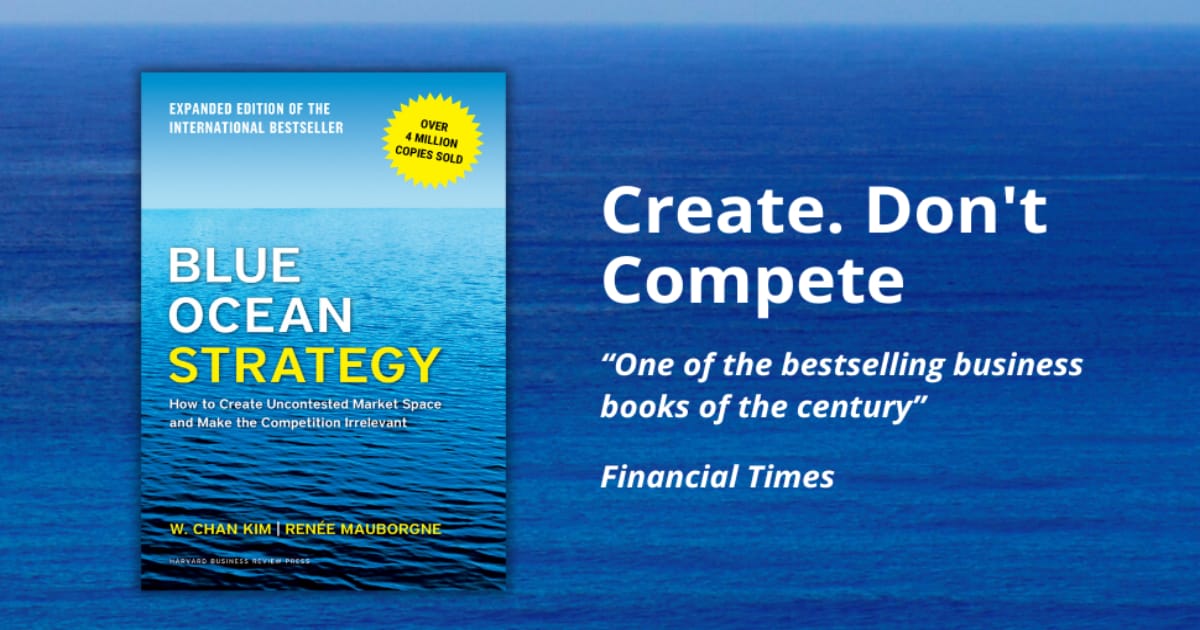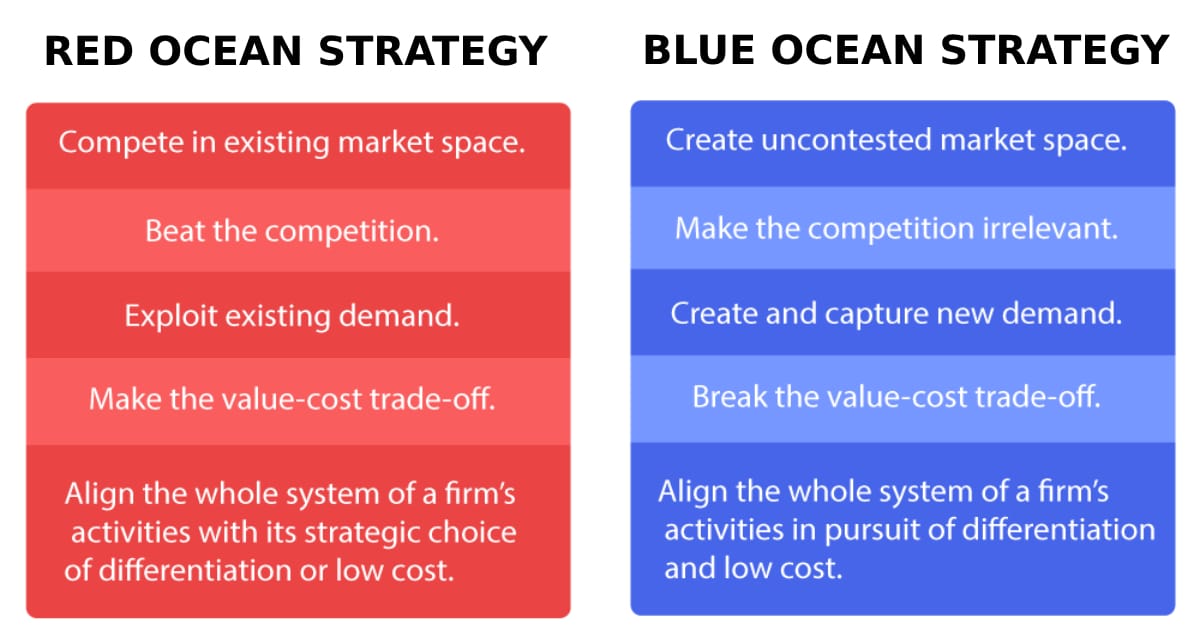Unlock the Power of the [Blue Ocean Strategy]

In the vast and competitive landscape of business, standing out and thriving requires a strategic approach that goes beyond conventional thinking. Enter the Blue Ocean Strategy—a revolutionary concept that encourages businesses to explore uncharted waters, creating uncontested market spaces ripe for innovation and growth.
In this article, we'll dive into the principles of the Blue Ocean Strategy and explore how it can transform the way companies approach competition.
Understanding the Blue Ocean Strategy

Coined by W. Chan Kim and Renée Mauborgne in their groundbreaking book "Blue Ocean Strategy," this approach contrasts with the traditional "Red Ocean" mindset, where businesses fiercely compete in existing market spaces. In a Red Ocean, companies fight for market share, leading to price wars and a focus on outperforming rivals. The Blue Ocean, on the other hand, symbolizes untapped market potential—a space where innovation and creativity reign supreme.
Key Principles:
- Create, Don't Compete: Instead of battling competitors in existing markets, the Blue Ocean Strategy encourages companies to create new markets. This involves identifying and solving problems that customers may not even be aware of.
- Value Innovation: The heart of the strategy lies in value innovation, where companies seek to deliver exceptional value to customers while simultaneously reducing costs. This shift in mindset sparks innovation that is both cost-effective and customer-centric.
- Focus on the Big Picture: Rather than fixating on incremental improvements, the Blue Ocean Strategy prompts businesses to consider the entire value chain. This holistic approach allows for transformative changes that impact the entire industry.
- Break the Value-Cost Trade-off: Blue Ocean pioneers challenge the traditional notion that value comes at a cost. Instead, they find ways to increase value while simultaneously lowering costs, creating a win-win scenario.
Applying Blue Ocean Strategy in Your Business

- Market Canvas: Develop a market canvas that identifies your industry's key factors and challenges. This will help pinpoint areas where innovation can create new value.
- Eliminate-Reduce-Raise-Create Grid: Use the ERRC grid to evaluate factors that can be eliminated, reduced, raised, or created to transform your value proposition.
- Visualize the Strategy: Create a visual representation of your strategy to ensure alignment and understanding among your team. Visualization is a powerful tool for strategic planning.
- Customer-Centric Approach: Prioritize understanding your customers' needs and pain points. Innovation that solves real problems is a cornerstone of the Blue Ocean Strategy.
5 Real-World Examples

1) Cirque du Soleil: Reimagining Entertainment
Cirque du Soleil disrupted the traditional circus industry by combining elements of theater and circus arts, creating a new form of entertainment. By eliminating animals, reducing costly acts, and targeting a more upscale audience, Cirque du Soleil carved out a Blue Ocean, making traditional circuses irrelevant to its audience.
2) Southwest Airlines: Low-Cost Air Travel
Southwest Airlines entered a crowded airline industry with a focus on low-cost, point-to-point travel. By avoiding hubs, offering no-frills service, and turning aircraft around quickly, Southwest created a Blue Ocean of affordable air travel, differentiating itself from competitors.
3) Nintendo Wii: Gaming for Everyone
While competitors focused on high-performance consoles, Nintendo introduced the Wii with motion-sensing technology, targeting a broader and more casual gaming audience. This innovative approach created a new market space and expanded the gaming industry.
4) Uber: Riding the Innovation Wave
Uber disrupted the taxi industry by introducing a convenient, app-based ride-hailing service. By leveraging technology, optimizing pricing, and providing a seamless user experience, Uber created a new market space, making traditional taxi services less appealing.
5) Yellow Tail Wine: Sipping Outside the Norm
Yellow Tail, an Australian wine brand, entered the competitive wine market with an approachable and affordable product. Instead of conforming to traditional wine marketing, they used colorful labels and positioned themselves as an easy-to-enjoy option for a broader consumer base.
Top Quotes
- "Competing in overcrowded industries is no way to sustain high performance."
- "The only way to beat the competition is to stop trying to beat the competition."
- "Companies have fallen into the trap of competing within the confines of the existing industry and trying to outperform rivals."
- "Value innovation is the cornerstone of blue ocean strategy. We call it value innovation because instead of focusing on beating the competition, you focus on making the competition irrelevant."
- "Blue ocean strategy challenges companies to break out of the red ocean of bloody competition by creating uncontested market space that makes the competition irrelevant."
- "To win in the future, companies must stop competing with each other. They need to invent a new game."
- "In blue oceans, demand is created rather than fought over. There is ample opportunity for growth that is both profitable and rapid."
- "Companies need to go beyond competing. To seize new profit and growth opportunities, they also need to create blue oceans."
- "Blue ocean strategy is based on the view that market boundaries and industry structure are not a given and can be reconstructed by the actions and beliefs of industry players."
- "Blue ocean strategy challenges companies to escape excessive competition and to carve out new market space that is both unique and ripe for growth."
Final Thoughts
Unlocking the power of the Blue Ocean Strategy requires a shift in mindset—from competition to creation, from incremental improvements to transformative innovations. By challenging industry norms and exploring uncharted territories, businesses can discover new opportunities for growth and success.
Embrace the Blue Ocean Strategy, and chart a course to uncontested market spaces where your business can thrive and make a lasting impact.





